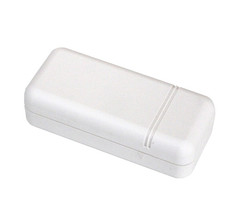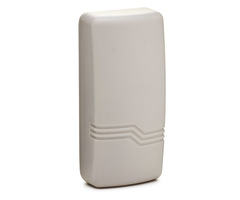Alarm Grid Video Recap: January 28th - February 7th
Posted By Michael GorisHi DIYers! We're hitting you with a video recap, this time covering January 28th thru February 7th. It has been a couple of weeks since we have last done this, so we have many new videos this time. Your boys Joe, Jorge and Jarrett are all back and ready to help you learn to use your system!
Using the Qolsys IQ Siren with a 2GIG Alarm System
Jorge shows users how to use the Qolsys IQ Siren with a 2GIG GC3 Alarm System. This Z-Wave siren produces sounds of up to 105 dB, and it features a built-in strobe light to provide a visual indication of an alarm. It also has an integrated backup battery so that it will work even when the power is out. This is an easy-to-use siren that is great for boosting the volume of a 2GIG Security System, as well as many other alarm control panels that work with Z-Wave.
Disabling Auto-Stay on a Honeywell LYNX Touch
Chipper Alarm Grid Team Member Jarrett demonstrates how to disable the auto-stay arming feature when using a Honeywell LYNX Touch Alarm System. Auto-Stay Arming has the system automatically revert to Arm Stay Mode when Arming Away if no entry/exit zone is activated during the exit delay countdown. If you want to put your LYNX Touch System into Arm Away Mode, you must either disable this feature or open and close an entry/exit sensor during the exit delay countdown.
Why Can't I Use Z-Wave Security Sensors With My Alarm System?
Jorge talks about how Z-Wave security sensors cannot be used with security systems supported by Alarm Grid. Z-Wave technology is great for use with smart home automation, and we have many systems that support Z-Wave lights, locks and thermostats. However, the Z-Wave communication protocol still isn't considered to be reliable and consistent enough to support security applications. For that reason, most alarm system manufacturers specifically design their security panels so that they cannot use or support Z-Wave security devices.
Changing the Master Code Using the Installer Code on a Honeywell Lyric
Jarrett walks users through the process of changing the Master Code by using the Installer Code on a Honeywell Lyric Alarm System. From the Installer Tools Menu, there is an option for resetting the Master Code back to its default of 1234. The user can then use the default Master Code to access the Users Menu and change the Master Code to a different four-digit code of their choosing. The Installer Tools Menu should be easy to access with the system disarmed since most users keep their Installer Code at the default of 4112.
Using the Smart Areas Feature on the 2GIG GC3
Jorge demonstrates the Smart Areas feature on a 2GIG GC3 Alarm System. This feature allows the system to support partitioning. In this case, the partitions are referred to as "Smart Areas". The system will support four distinct Smart Areas after the feature has been enabled from within system programming. After enabling the feature, a Smart Areas menu option will appear on the main system screen. Please note that your GC3 System must be running firmware version 3.2 or higher to support the feature.
Streaming Alarm.com Cameras to the Qolsys IQ Panel 2
Joe shows users how they can stream Alarm.com Security Cameras directly to their Qolsys IQ Panel 2 System. This feature is only compatible with certain ADC Camera models. You will need to enable the feature within Alarm.com for this to work. In addition to streaming video, some camera models will also allow your to stream live audio on the panel as well. Please note that your IQ Panel 2 System will need to be running firmware version 2.2.1 or higher to support this feature.
How to Safely Remove an iControl from an Existing System
Joe walks users through the proper procedure for removing an iControl module from a Honeywell VISTA Panel. There have been many users who have removed iControl modules from their systems, only to find out later that their keypads do not function properly. This can be prevented by following the correct steps when removing an iControl device. The proper procedure involves powering down the VISTA System before removing and reconnecting the keypad cable to the ECP bus afterwards.
Is Monitoring Required to Use Home Automation with the Interlogix Simon XTi-XTi-5
Jorge talks about how alarm monitoring service is required to use smart home automation with an Interlogix Simon XTi or Simon XTi-5 Alarm System. The reason that these systems require alarm monitoring for home automation is because the Alarm.com Cellular Communicator is actually also the Z-Wave controller. The cellular communicator must be installed and activated with Alarm.com for Z-Wave functionality to work on the system. A user can then control their Z-Wave devices from the panel or through the Alarm.com website or mobile app.
Finding the Serial Number on a Honeywell 5800PIR-RES
Jorge mentions the possible ways to find the Serial Number on a Honeywell 5800PIR-RES Motion Sensor. The easiest option is to check a sticker on the back of the sensor that lists the Serial Number. If the sticker has been removed, you can also auto-enroll it to the panel. The Serial Number will be displayed on the screen after you have learned it in. This can also be useful for confirming that the Serial Number on the sticker is correct.
Honeywell Panels Compatible With the SEM
Jorge explains which of the Honeywell Panels will work with an Alarm.com System Enhancement Module (SEM). An SEM is a cellular communicator that allows a Honeywell System to work with the Alarm.com service. This is rather unique because Honeywell Systems would normally work with Total Connect 2.0 instead. The SEM devices will work with any of the lower VISTA P-Series Panels, as well as their First Alert equivalents. These modules also include built-in Z-Wave controllers for smart home functionality.
Updating the Firmware on a Vista-P Alarm System
Joe covers the process for updating the firmware on a Honeywell VISTA Series System. This is done by replacing the PROM chip. The PROM chip can be identified as a small black chip on the system board. Upgrading to a new one can be necessary for unlocking certain features. You should always make sure to power down the system entirely whenever you are replacing the PROM chip. Alarm Grid sells VISTA-15P PROM Chips, VISTA-20P PROM Chips and VISTA-21iP PROM Chips.
Okay, so this isn't really a video to help you use a security system. But it is a nifty introduction montage that our video team put together. Many of the Alarm Grid techs and employees are featured, including Jorge, Jarrett, Joe, Dylan and Bryce. I even make a brief appearance! We're very proud to have helped many people get the most out of their security systems. If you're a monitored customers and you ever need further help, please reach out to us by emailing support@alarmgrid.com. Also make sure to like us on YouTube, and subscribe for further updates!


































